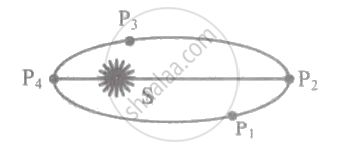Advertisements
Advertisements
प्रश्न
What is the direction of areal velocity of the earth around the sun?
उत्तर
Areal velocity of the earth around the sun is given by `(dA)/(dt) = L/(2m)` where L is the angular momentum and m is the mass of the earth.
But angular momentum `L = r xx p = r xx mv`
∴ Areal velocity `((dA)/(dt)) = 1/(2m) (r xx mv) = 1/2 (r xx v)`
Therefore, the direction of areal velocity `((dA)/(dt))` is the direction of `(r xx v)`, i.e., perpendicular to the plane containing r and v and directed as given by the right-hand rule.
APPEARS IN
संबंधित प्रश्न
A Saturn year is 29.5 times the earth year. How far is the Saturn from the sun if the earth is 1.50 ×108 km away from the sun?
Observe the given figure showing the orbit of a planet moving around the Sun and write the three laws related to it:

The orbit of a planet moving around the Sun
Write the Kepler's laws.
State Kepler’s laws.
If the distance between the sun and the earth is made three times, then attraction between the two will ______
A planet is revolving around the sun in an elliptical orbit as shown in figure. At which point will its K.E. be maximum?

The mass and radius of earth is 'Me' and 'Re' respectively and that of moon is 'Mm' and 'Rm' respectively. The distance between the centre of the earth and that of moon is 'D'. The minimum speed required for a body (mass 'm') to project from a point midway between their centres to escape to infinity is ______.
Both earth and moon are subject to the gravitational force of the sun. As observed from the sun, the orbit of the moon ______.
Supposing Newton’s law of gravitation for gravitation forces F1 and F2 between two masses m1 and m2 at positions r1 and r2 read F1 = – F2 = `- r_12/r_12^3 GM_0^2 ((m_1m_2)/M_0^2)^n` where M0 is a constant of dimension of mass r12 = r1 – r2 and n is a number. in such a case.
- the acceleration due to gravity on earth will be different for different objects.
- none of the three laws of Kepler will be valid.
- only the third law will become invalid.
- for n negative, an object lighter than water will sink in water.
Earth’s orbit is an ellipse with eccentricity 0.0167. Thus, earth’s distance from the sun and speed as it moves around the sun varies from day to day. This means that the length of the solar day is not constant through the year. Assume that earth’s spin axis is normal to its orbital plane and find out the length of the shortest and the longest day. A day should be taken from noon to noon. Does this explain variation of length of the day during the year?
